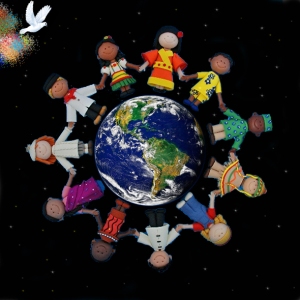Learning tolerance starts at an early age. Religious diversity and tolerance education for young children
Worldwide recently was celebrated one of the most important Christian holidays – the Easter. For many people this holiday has no importance. We live in a world of cultural, ethnic and religious diversity, world that children are facing in the earliest age. This reality challenges us to ask questions about the education of children in terms of diversity. In this article I will focus on religious diversity and the importance of teaching children tolerance.
I consider it is important that children develop a tolerant behavior as early as possible. Studies show that from an early age children begin to form ideas about themselves and about others. Sharon Penchina C. Ht. argues that at the age of three they start to notice cultural and ethnic differences, such as the fact that people have different dishes and different holidays than those that they celebrated in their family. As children begin to notice differences in such an early age, it is very important that they learn tolerance as early as possible. The ability of children to accept differences puts them in an ideal position to learn tolerance.
What is tolerance? In this article, the tolerance represents the respect of the freedom of the other in terms of its different mode of thinking and behavior. Regarding religious diversity, Larousse dictionary defines tolerance as an attitude of respect for those who have a different religion or religious doctrine. In other words, although I do not share your religious faith and practices, I respect you as a person. But not any behavior must be accepted. According to human rights, UNESCO stresses the idea that the practice of tolerance does not mean toleration of social injustice or to renounce to your own beliefs.
Why should we teach children the tolerance? Education for tolerance should aim at preventing discrimination and marginalization, which are common forms of intolerance. UNESCO argues that tolerance education should help young people to develop their ability to think critically and ethically.
Tolerance is considered by Professor Dr. Thorsten Knauth as a precondition for living together peacefully in a context of religious and cultural diversity. Religion has a strong influence on people and their actions in society. Therefore, according to the United Nations (Summit on the culture of peace, November 2008) tolerance is an important factor that encourages the interfaith dialogue. Also intergovernmental organizations such as the United Nations, Council of Europe, the European Commission and the OSCE (Organization for Security and Co-operation in Europe) encourage the introduction of educational programs in European schools on religious diversity, in order to increase tolerance for diversity and thus contributing to social cohesion. Most of the time, learning tolerance is associated with concepts such as civic education, education for peace, human rights education, intercultural dialogue and interreligious education.
How should we teach children the tolerance? Honest and constructive communication. Speak openly and listen to the child talking about differences, similarities and accepting these things with honest communication about racism, discrimination and stereotypes can be considered as training to face these challenges later in life. Children need answers to questions about specific situations that they encounter with their peers, and adults must be prepared to give them appropriated answers and participate this way to their training for a tolerant behavior. Children should be taught that stereotypes, prejudice and racism are wrong. They should be encouraged to respect people regardless of the religion or culture differences.
Active Education. One of the main ways of educating is modeling the behavior of the child by the active example of the adult. If the adult don’t tolerate the differences in others, the child that grows up next to him will do the same. Children follow the example that they find in the adults that they meet most frequently (usually parents and other caregivers, either in the family context or in the (pre) school for those who attend an educational institution).
Cited sources in this article:
UNESCO, Promuvoir la tolérance, mars 2014, available on-line
UNESCO, Déclaration de principes sur la tolérance, 16 novembre 1995
http://portal.unesco.org/fr/ev.php URL_ID=13175&URL_DO=DO_TOPIC&URL_SECTION=201.html
S. Penchina C. Ht., Teaching Tolerance by Celebrating Diversity, Parent’s Source, February, 2006, available on-line
http://www.2imaginethis.com/wp-content/uploads/2013/07/TeachingTolerancebyCelebratingDiversity.pdf
Professor Dr. Thorsten Knauth , Tolerance – a Key concept for dealing with cultural and religious diversity in education, available on-line
http://www.theewc.org/uploads/files/State%20of%20the%20Art_Knauth_alt.pdf
4 réponses à “Learning tolerance starts at an early age. Religious diversity and tolerance education for young children”
Rètroliens / Pings
- - novembre 20, 2014




This is so true. Teaching your children to be tolerant not only when it comes to religion but also other differences (weight, sexual orientation, social class, cultural background) is the best thing a parent can teach.Tolerance makes people feel empathy for others and maybe grow up to become great leader of the world. Because, what kind of principle must some live by, if they become corrupt leaders, or tyrans?
God help us see, understand and act !
J’aimeAimé par 1 personne
That’s right, Anna, teaching tolerance should include several things in the social life of a child. We are different and we should teach children that this is a richness and not something they have to be ashamed of.
J’aimeAimé par 1 personne
Very well said! 🙂
J’aimeJ’aime